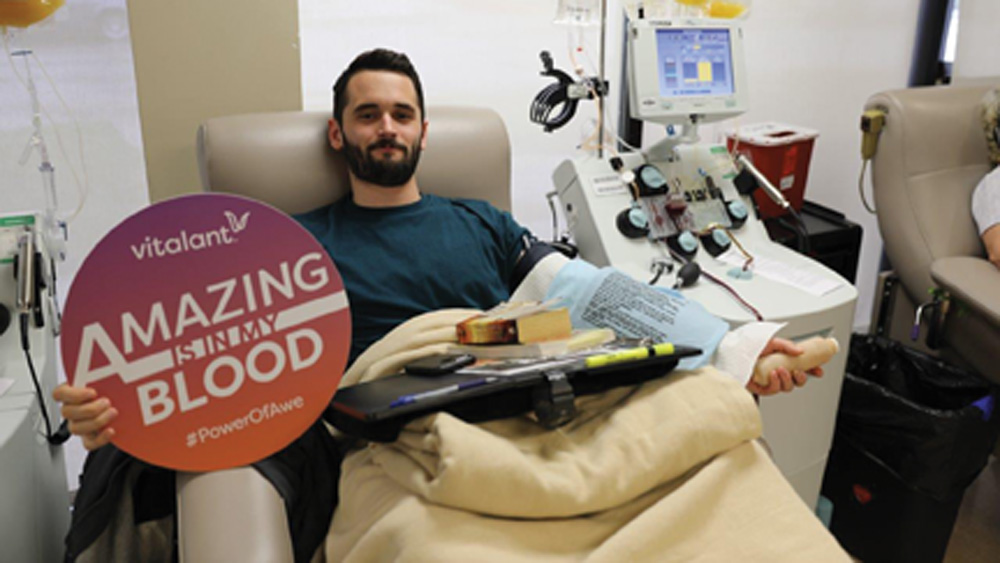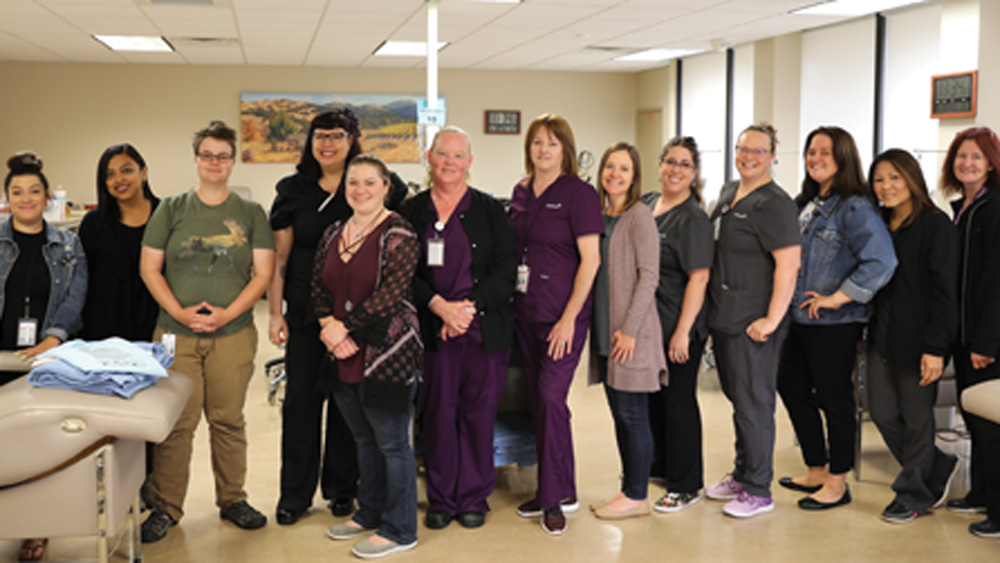
Every two seconds someone in the U.S. needs blood—for surgeries, cancer treatments, chronic illnesses and traumatic injuries. Blood is the essential life force that cannot be manufactured. Less than 38 percent of the population is eligible to give blood or platelets and with each having a short shelf life, especially platelets, blood banks are continually seeking volunteer donors to ensure a steady supply. Blood banks have been operating in the North Bay for more than 70 years, but never encountered a pandemic the likes of what we’ve seen in 2020.
Keeping up supplies
An essential business, blood banks never closed during the quarantine, however, hundreds of local blood drives were cancelled as schools and businesses closed. Vitalant—previously known as Blood Centers of the Pacific—had nearly 280 blood drives cancelled in the San Francisco Bay Area by May 21, resulting in 7,000 uncollected units of blood.
“In the Bay Area, Vitalant needs about 500 donations per day for the approximately 50 hospitals we serve,” says Kent Corley, marketing and communications specialist for Vitalant in Santa Rosa. “When it became common knowledge that we were in a pandemic, companies that had scheduled blood drives with us started cancelling.”
While blood banks take donations at its centers, their core supply under normal circumstances comes from being in the community seven days per week in their bloodmobiles, visiting school auditoriums, corporate conference rooms, community centers and churches. The strategy makes it convenient for donors, but recent health restrictions have now made most of these events impossible to execute.
Fortunately, shortly after the shelter-in-place orders went into effect, demand for blood decreased with fewer accidents and trauma situations, no elective surgeries taking place, and even some necessary procedures postponed during the first few volatile weeks.
“Since the shut-down was so complete, on a national level, what we didn’t expect to happen was that the patients who needed blood in hospitals also turned off, significantly,” says Corley. “All the elective surgeries didn’t happen, many cancer patients who usually need platelets and other immune compromised individuals also delayed treatments for a while.”
However, as individuals return to work and other activities, and elective surgeries are being scheduled again, demand is increasing, and blood banks still can’t use their mobile blood donation vehicles.
“Since June 1, we’ve seen about a 25 percent increase in the need from hospitals,” says Kevin Adler, Vitalant marketing and communications manager for the Bay Area. “But a lot of the obstacles of trying to collect [blood] are still in place. We’re still not able to collect with bloodmobiles and a lot of businesses are unable to hold blood drives at their locations. They don’t want to have large gatherings.”
The blood bank actively reached out to their existing donor base and communicated through social media and other news outlets their need for individual donations to make up for what is being lost through the lack of donation events. Fortunately, many people have stepped up and at the time of this writing most donation appointments for the next few weeks have already been reserved. During times of disasters, or in this case a pandemic, many people who may not necessarily be regular donors feel the need to donate blood as one thing they can do to help others in an otherwise helpless situation.
“The community has been super supportive in heeding the call and coming out to donate with everything else that’s been going on,” says Adler. “Blood donors before this were amazing but even after all this, having to shelter-in-place and all the precautions, they’re still showing up. It just goes to prove how amazing they are, to generously give of themselves no matter what’s going on, no matter what obstacles are placed in front of them. We also saw a large uptick in first-time donors, and others who show up in times of need.”
Critically important are platelet donations, which only have a shelf-life for five days, versus the 42-day shelf-life of whole blood. Platelets are always needed by patients for cancer treatments, surgeries and emergencies. In fact, cancer patients are the No. 1 recipients of blood donations than any other disease. With four main blood types, A, B, AB and O, and each type having a positive and negative, there are eight groups in total that continually need supply. Currently, there is an especially high need for type O, A-negative and B-negative red blood cells.
Modifying protocols
Given the nature of blood banks, safety practices are always in place such as sterilization protocols, ensuring the health of donors prior to giving blood and taking temperatures. Since the pandemic, however, some extra steps are being employed, including taking an individual’s temperature immediately at check-in versus during the preparation process as in the past, requiring facial coverings for both donors and staff, as well as staggering appointment times to minimize multiple people waiting in the same room at the same time.
Vitalant does not test specifically for COVID-19, as there has been no scientific evidence that it can be transferred through a blood transfusion. However, it became the first national blood bank (as of June 1) to test all blood donations for antibodies to SARS-CoV-2, the coronavirus that causes COVID-19. The organization added this extra test through the end of July and provided donors with the test results, in addition to the rest of the full panel of tests that Vitalant performs on blood donations.
“We always took people’s temperature and blood pressure, and we test hemoglobin levels,” says Corley. “Once you make a blood donation, you have a platelet count as part of your donation. You will learn that about yourself. All the donors get a health history that’s online on your account.”

The antibody test shows if a donor’s immune system produced antibodies to the virus, regardless of whether or not they showed symptoms. While a positive antibody test does not necessarily mean that someone is immune to Covid-19, it does mean that they may be eligible to donate convalescent plasma in the future and help people with the disease. Convalescent plasma, the liquid part of blood that is collected from patients who have recovered from COVID-19, has antibodies, or proteins, that might help fight the infection.
“It’s a win-win situation,” says Adler. “You get to find out your antibody status and you get to help save lives. It’s free for the donor and is strictly for the donor’s information; it’s not being shared with anyone.” Donors find out in a week or two after making a donation to the blood bank. They can log into their account to find their antibody status. It’s just another one of the litany of tests that every single donation goes through. “It’s one of the beauties of donating. It’s like getting a mini physical,” he adds. “You find out your blood pressure, and your cholesterol level. It’s not a true measure of your cholesterol because that would require fasting, but it gives you a rough estimate. You get your heart rate, and your iron levels. We give you a mini-physical because you have to be healthy to donate.”

Changing restrictions
A new development in blood banks is the loosening of some restrictions allowing more people to donate that may have not been able to in the past. Some of those restrictions were eased in the early part of the pandemic. For example, it’s a common misconception that individuals who obtained a tattoo within the last few months cannot donate blood. However, today people can donate the same day as receiving a tattoo, as long as it was created by a licensed tattoo artist.
“The FDA recently loosened certain eligibility requirements that’s going to allow people to donate for the very first time who weren’t able to donate before,” says Adler. “The only caveat is it takes some time for the donation centers to implement these changes. So we’re looking to have the changes at Vitalant happen by the end of August. We’re working as quickly as possible to get it done.”
One of the changing requirements is that individuals who spent a certain amount of cumulative time in many European countries in the 1980s and 1990s, even on a military base, couldn’t donate because of concern for Mad Cow disease. When the requirement change goes into affect they can immediately donate with no deferral or waiting time.
Another restriction is for those who have traveled to an area at high-risk for malaria. Previously they couldn’t donate for 12 months. That waiting period has been reduced to three months.
“In the Bay Area that’s a really big deal,” says Adler. “It’s just a melting pot of everybody, and people are going everywhere, especially in the tech community. So having that down to three months is big.”
A third change is one that affects the LGBTQ community. Before the pandemic, male donors who had sex with another man had to wait 12 months to donate blood. That timeframe was reduced to three months.
Make it a habit
Vitalant urges everyone to give blood as soon as possible, and even better, become a regular donor. Blood can be donated every eight weeks, and platelets can be donated 24 times per year. The typical COVID-19 related safety precautions are in effect, such as temperature checks at check-in, social distancing within the center and mask requirements. In addition, Vitalant strongly recommends making an appointment online versus walking in, so it can stagger appointments to ensure social distancing measures.
“People were looking for ways to give back [during shelter in place] and we’re hoping they continue to do that,” says Adler. “They come in once, they realize how easy the process is, how safe it is, the importance of what they are doing, and come to the realization that they should be doing this more often. That’s what we want to hear. We want those donors to make a habit out of it. We want them to say I did it once and am going to keep doing it again and again because it’s so important to the community.”



